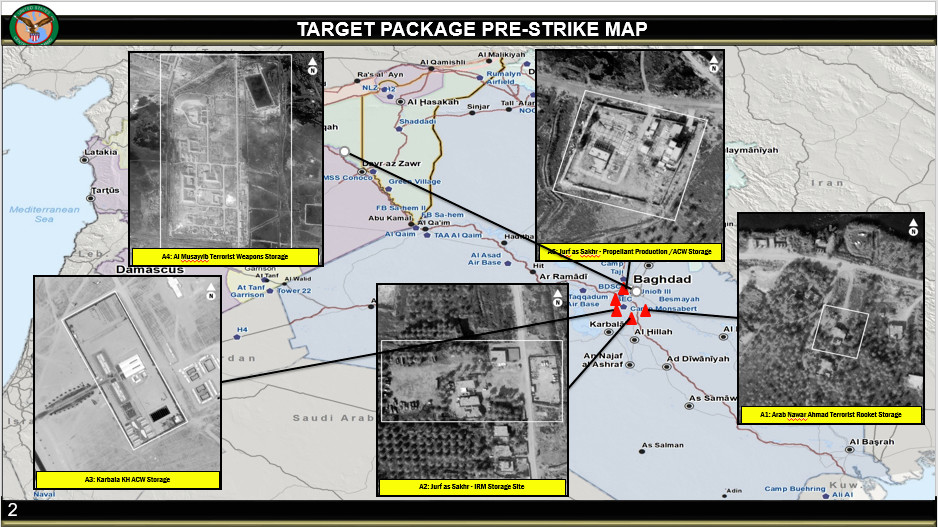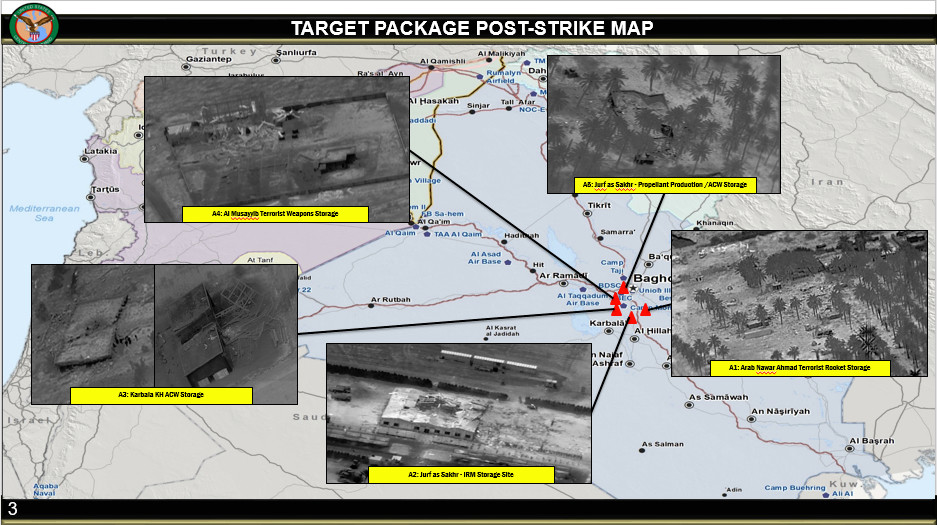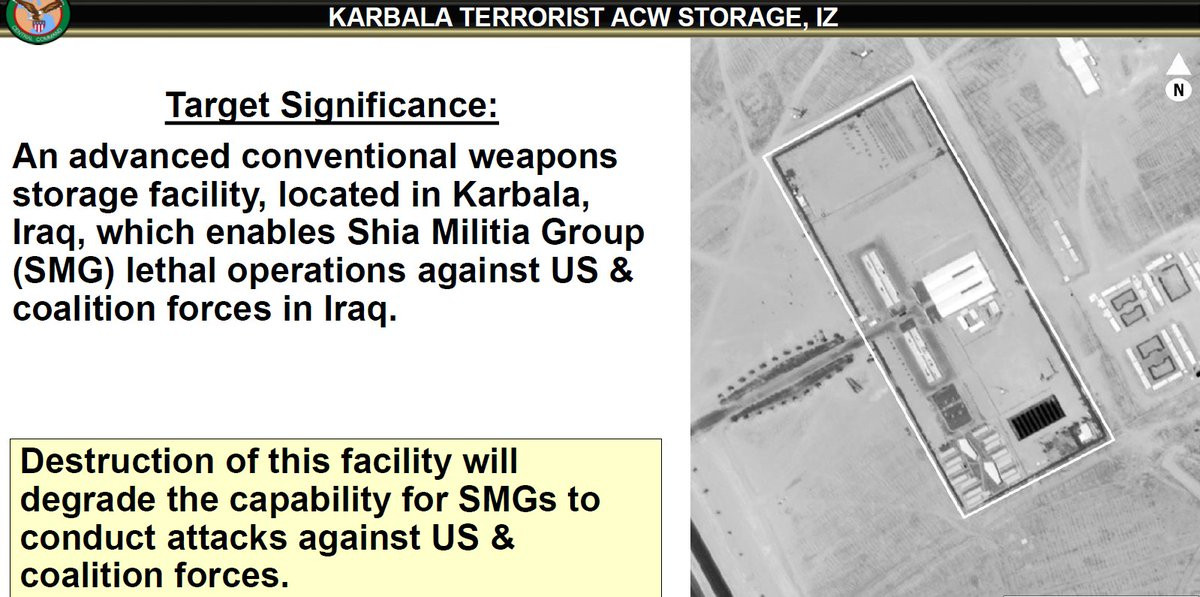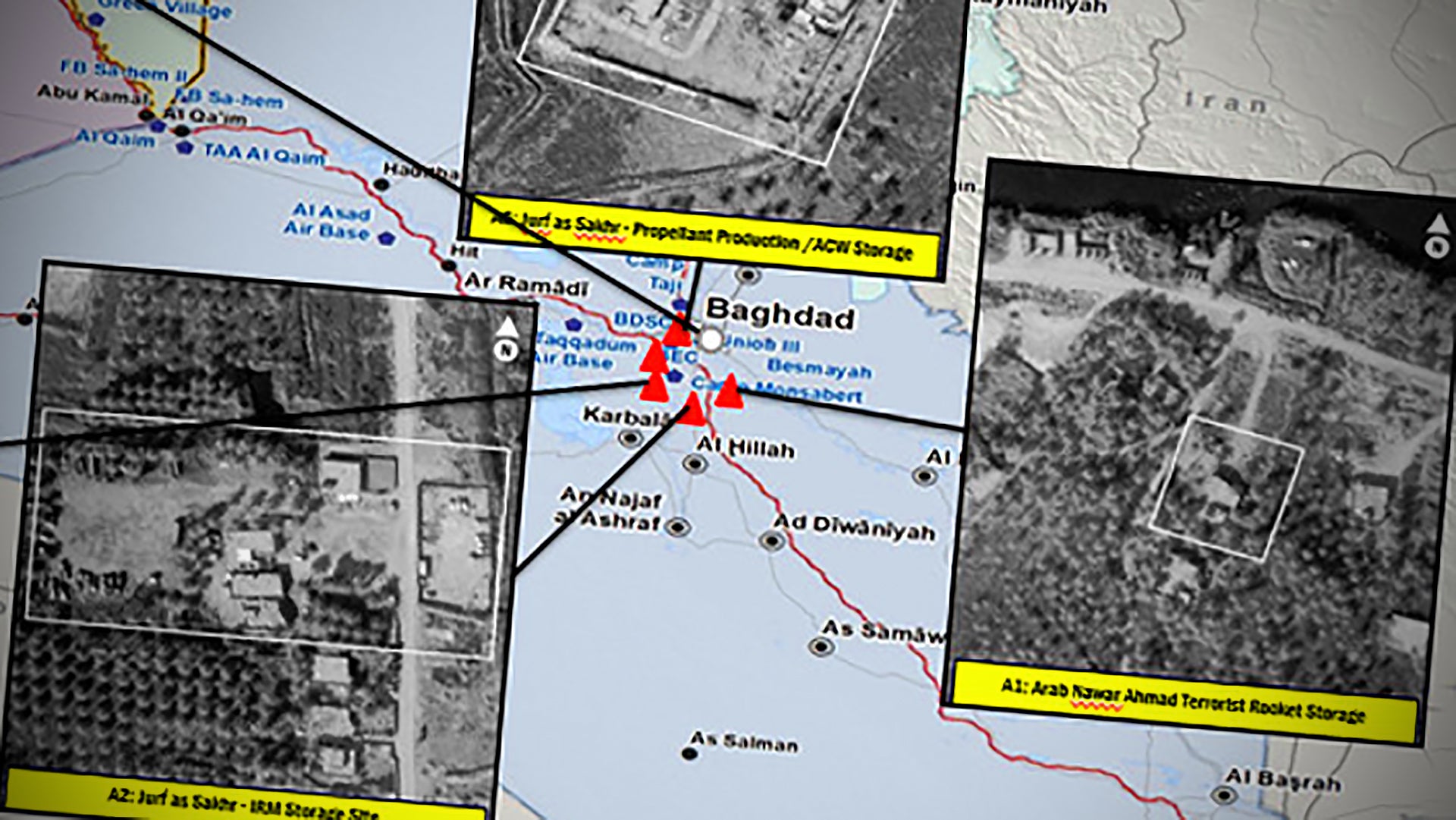America’s top U.S. commander for operations in the Middle East briefed reporters this morning on the American airstrikes in Iraq last night on five sites associated with Kata’ib Hizbollah, an Iranian-backed Iraqi militia. He also offered additional details on the rocket attack on Taji Air Base outside of Baghdad that killed two U.S. military personnel and one British service member earlier this week, which prompted these strikes in the first place.
Here is a breakdown of the new information that U.S. Marine Corps General Frank McKenzie, commander of U.S. Central Command (CENTCOM), as well as CENTCOM’s public affairs office, has now provided on the rocket attack on Taji and the American response:
- McKenzie blamed the Taji rocket attack on Kata’ib Hizbollah, but would not say whether Iranian officials had ordered it.
- The improvised rocket launcher could have fired up to 33 rockets, but only 30 functioned properly.
- Of the 30 launched, only between eight and 15 rockets actually struck Taji.
- Unspecified radars, possibly artillery counter-battery radars, such as the AN/TPQ-53, helped determine the point of origin of the attack.
- U.S. personnel are examining the launcher and the three unfired rockets to gather additional intelligence.
- “That vehicle may have moved around for a month … because they know we’re looking,” McKenzie noted.
- “Had we seen that truck, we would have taken action … they know that, as well,” he added.
- McKenzie said that there was evidence that Kata’ib Hizbollah had been responsible for a total of 12 rocket attacks aimed at bases where members of the U.S.-led coalition are situated in Iraq in the past six months.
- McKenzie stated that the United States is in “constant communication” with Iraqi authorities about these kinds of hostile rocket attacks and said there were indications that Iraqi security forces had made some effort to prevent militias from doing so.
- McKenzie also said that a total of 18 military personnel and civilians had also been injured in the attack, but did not specify their injuries or their assigned units or nationalities.
- The Pentagon had previously said that 14 members of the U.S.-led coalition had been injured.
- The Pentagon has identified the two U.S. servicemember who died in the rocket attack on Taji as U.S. Army Specialist Juan Miguel Mendez Covarrubias and U.S. Air Force Staff Sergeant Marshal Roberts.
- Specialist Covarrubias was assigned to the 1st Battalion, 227th Aviation Regiment, part of the 1st Air Cavalry Brigade, 1st Cavalry Division.
- Staff Sergeant Marshal Roberts was assigned to the 219th Engineering Installation Squadron, Oklahoma Air National Guard.
- The United Kingdom had identified the British service member killed as Lance Corporal Brodie Gillon, a British Army reservist, yesterday.
- The U.S. military conducted the “precision defensive strikes” on Kata’ib Hizbollah around 1:00 AM local time in Iraq on Mar. 14.
- The airstrikes targeted five different sites that contained “advanced Iranian-supplied weapons”:
- A target in Arab Nawar Ahmad, Babil Province, Iraq, described as a “terrorist rocket storage” location.
- A target in Al Musayyib, Babil Province, Iraq, described as a “terrorist weapons storage” location.
- A target in Jurf Al Sakhar, Babylon Province, described as an “IRM [improvised rocket-assisted munitions] storage site.”
- A target in Jurf Al Sakhar, Babylon Province, described as a “propellant production / ACW [advanced conventional weapon] storage” location.
- A target in Karbala, Karbala Province, described as an “ACW storage” location.



- All of these sites were known to U.S. forces beforehand.
- There are other known Kata’ib Hizbollah sites in Iraq containing Iranian-supplied weapons, including some situated in locations where there would be a much greater risk of collateral damage.
- Manned fighter aircraft conducted all of the strikes.
- McKenzie would not say what type of aircraft or munitions were employed, or where the planes launched from, but said that they all returned to base without incident afterward.
- “We are confident we have effectively destroyed these facilities and expect that they will no longer be able to house the type of advanced Iranian-supplied weapons that were used in the Kata’ib Hizbollah attacks at the Iraqi base at Camp Taji,” McKenzie said.
- CENTCOM is still assessing the full extent of the damage to the facilities, the total number of Kata’ib Hizbollah casualties, and any collateral damage, with poor weather in Iraq hampering those activities.
- “I have no information on any IRGC [Islamic Revolutionary Guard Corps] general being killed or injured,” McKenzie said.
- There had been unconfirmed reports that a senior officer belonging to Iran’s IRGC had died in the strikes.
- “The strikes you see now are designed to send a clear, unambiguous signal that we will not tolerate this behavior in the future going forward,” McKenzie said.
- McKenzie said that the U.S. had consulted with Iraqi authorities in the wake of the Taji rocket attacks and that they were aware a response would be coming.
- The strikes were not directly coordinated with the Iraqi government, which claims that an Iraqi Army and Federal Police units were among those struck.
- “I think the threat [from Iran and its regional proxies] remains very high. I think that tensions have actually not gone down,” McKenzie said.
- He further described the situation in the region as an “illusion of normality.”
- He warned that the impact of the COVID-19 novel coronavirus in the region, especially within Iran, could exacerbate the situation.
- Preparations are underway to deploy Patriot surface-to-air missile systems to Iraq to protect against future higher-end missile threats, such as Iranian ballistic missile strikes.
- Land-based Phalanx close-in weapon systems, designed to shoot down incoming rockets, artillery shells, and mortar bombs, are also being deployed.
- The Phalanx systems will be used to guard the Patriot sites.
- “Once the Patriots come in, they become a very high-value target,” McKenzie said.
- The Phalanxes “can’t be everywhere at once,” he added.
- “If I were to put one at Taji, it would have to come from another defended location,” he continued.
- The U.S. Navy is now operating two Carrier Strike Groups, the Truman Carrier Strike Group and the Eisenhower Carrier Strike Group, in the region as part of a posture to respond to any future aggression from Iran or its regional proxies.
- This is the first time since 2012 that two Carrier Strike Groups have been simultaneously forward deployed to the region.
- “We have the flexibility, capability, and will to respond to any threat,” McKenzie said.
How the situation in Iraq, and with regards to tensions between the United States and Iran and its proxies elsewhere in the Middle East, continues to evolve remains to be seen. The Iraqi Security Media Cell, tied to the office of the country’s Prime Minister, a post that is technically vacant at present, decried the U.S. airstrikes in a series of Tweets on Mar. 14.
“The argument that this attack was in response to the aggressive action that targeted the Taji camp is a flimsy pretext and leads to escalation and does not provide a solution to control the situation, but leads to escalation and deterioration of the security situation in the country and exposes everyone to more dangers and threats,” one Tweet read. “This attack is not a partnership or respect for Iraq’s sovereignty and the integrity of its land, its skies, and its citizens, and it will have consequences that will be felt by all at the greatest risk, if not controlled, and respect for the will and policies of the Iraqi state.”
The U.S. government’s decision to kill Iranian General Qasem Soleimani, then head of Iran’s Quds Force, in Baghdad in January was met with similar criticism and prompted pro-Iranian politicians to demand all American troops leave the country. The strike on Soleimani had followed another fatal Kata’ib Hizbollah rocket attack aimed at U.S. personnel in Iraq, after which the United States had also struck various sites belonging to that group.
With the U.S. response limited to Iraqi militias, so far, it is less likely that there will be any immediate direct response from Iran. The Iranians had launched ballistic missile strikes on American troops in Iraq following the death of Soleimani.
All told, as General McKenzie said, the “threat remains very high” and the situation in Iraq remains extremely fluid.
Contact the author: joe@thedrive.com
